Facing stone for the facade: varieties and features of installation
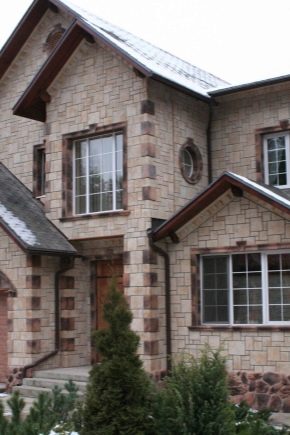
The facade of the house is the business card of the owners. And if you decide to distinguish your house from others, then you should pay attention to its facing with stone, since even a modest house with a stone facade attracts much more enthusiastic looks than a three-story cottage. Stone décor gives the home a more presentable and luxurious look, which speaks to the taste, lifestyle and style of the owner. Therefore, we can say with complete confidence that stone cladding is unmatched.

Peculiarities
Stone has been used in the construction of houses for hundreds of years. And today, facing stone occupies a leading position among the methods of decorating the facade of a house, second only to popular plaster. In addition to the fact that the stone facade has an attractive and original appearance, it also gives additional strength and extends the life of the walls.
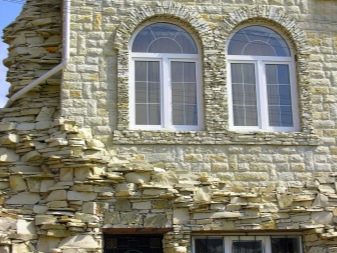

The stone façade has been at its peak for many years and there are many reasons for this:
- A variety of materials - today builders and designers offer natural and artificial finishing materials.
- A wide variety of shapes and colors - modern finishing materials are available in various shapes: rectangular or square tiles, stripes, solid slabs.
- Eco-friendly material - natural and artificial stone is absolutely safe for humans.
- The original appearance - the stone facade is able to give the building majesty and grace. The beauty of the natural design transforms the façade into a unique piece of art.
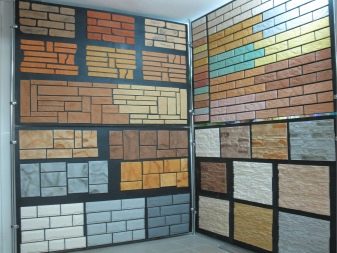
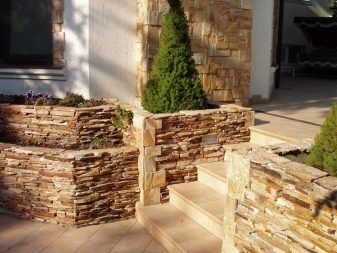
- The ability to cover the house in whole or in part - in any case, the facade will look more advantageous against the background of neighboring buildings.
- Increases fire safety - the stone does not support the combustion process and does not spread fire.
- Practicality and reliability - the facade stone is resistant to high humidity, temperature extremes and mechanical stress. In addition, an additional layer of stone extends the life of the outer walls and the building itself.
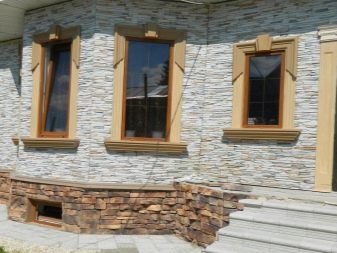
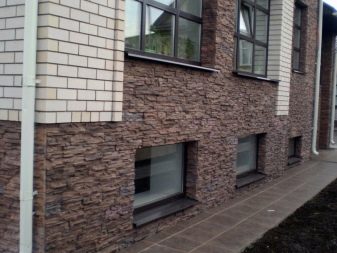
- Additional soundproofing.
- Increases thermal insulation - natural stone also serves as an additional thermal insulation layer. It is cool in summer in such a house, and warm in winter.
- Easy to maintain - the stone façade does not need to be polished or painted.
- Durability - it will last for many years.
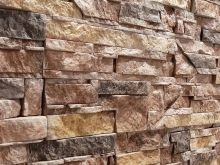
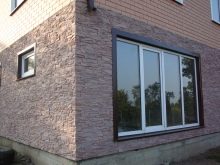
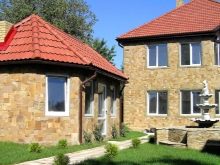
Types of materials
All materials are divided into two groups: natural and artificial. Natural materials are cut into small slabs and natural stone is processed and calibrated.
The front part is left embossed, and the seamy side is made flat to simplify the installation process.
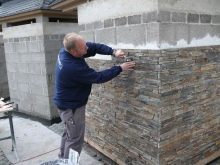
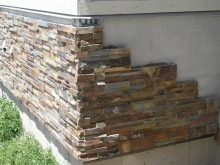
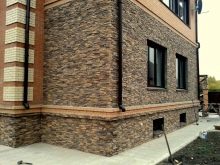
Among the most popular natural stones for facade cladding are:
Marble
It has a rich color range and belongs to the most expensive finishing materials. For facade cladding, polished medium-density marble is most often used. In direct sunlight, this gives the surface a deeper and richer color.
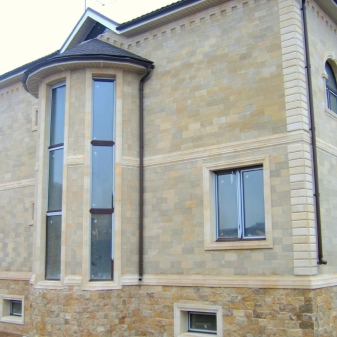
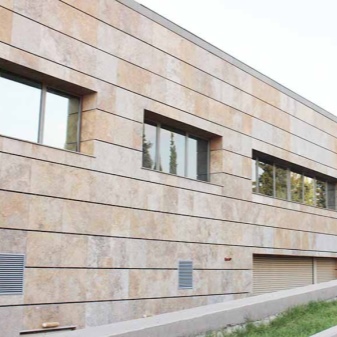
Granite
Also applies to the elite segment of materials. When finishing the facade, both polished (glossy) and unpolished (matte) stone are used. Manufacturers offer granite in various sizes. The most popular are large slabs and medium-sized paving stones.

There are three types of granite:
- plagiogranite - has a predominantly light gray tint;
- alaskite - has a pink tint;
- porphyry granite - is something in between other types and has a pink tint with small light gray blotches.
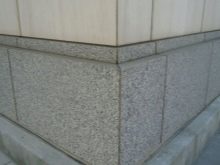
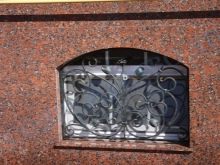
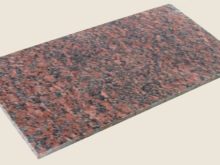
Granite is not affected by any climatic factors.
But in addition to a large number of advantages, it also has disadvantages - this is a high cost of material and an impressive weight.
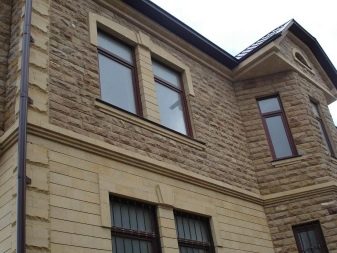

Limestone
It can have any shape - from the classic rectangular and square to polygonal. The material can have a raised chipped surface or be sanded and have a matte smooth side. Most often, the stone is white and yellow.
Limestone can be called a ductile and malleable material; during processing, it can be given any shape. Only limestone with a calcite content of up to 98% is used as a facing material, which indicates the high strength and reliability of the stone. It was not for nothing that the Egyptians used it to build the pyramids. But limestone is not suitable for a sharply continental climate. With the change of seasons, high humidity and temperature changes, the stone can collapse.
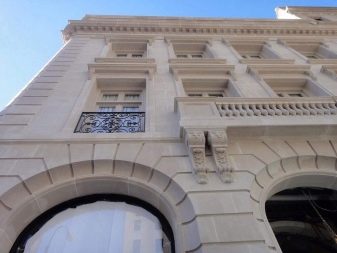
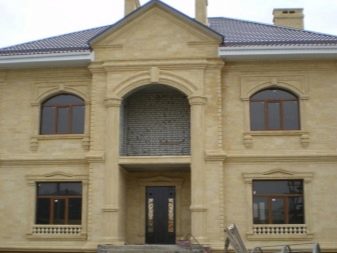
Labradorite
A beautiful stone with a blue, red or yellow pattern. It is a durable and reliable finishing material that is not afraid of climatic changes.
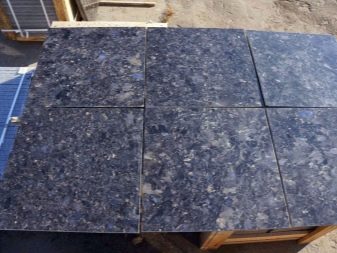

Sandstone
An inexperienced person may confuse it with limestone. Both stones are similar in color and size. The stone is slightly rough to the touch and can have a beige, yellow or brown tint. Sandstone is considered to be a more durable and reliable material.
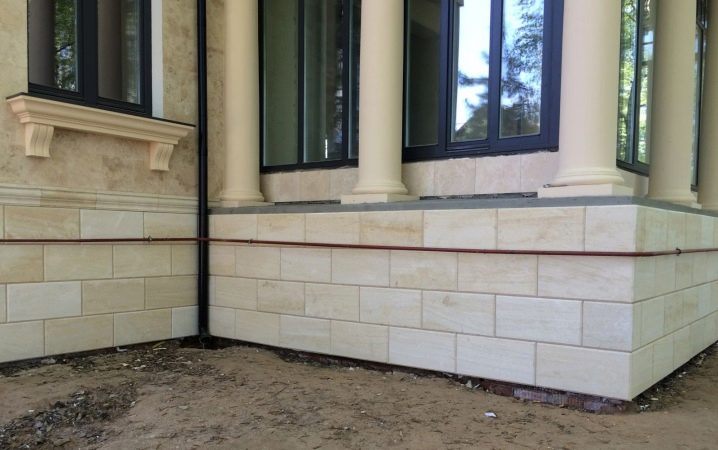
There are 4 types of stone:
- oolitic;
- pisolitic;
- shell rock;
- lithographic.
But only the first two types are suitable for facing the facade: oolitic and pisolitic sandstone. And shell rock and lithographic are used for the construction of buildings. Slate - has a smooth and flat surface.
Compared to other natural materials, it has a lower weight, which allows it to be used also for interior work.

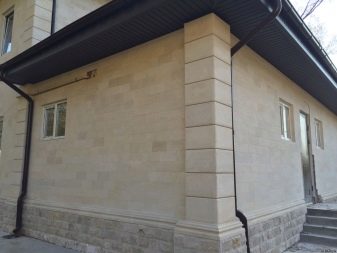
Slate
Has a smooth and flat surface. Compared to other natural materials, it has a lower weight, which allows it to be used also for interior work.
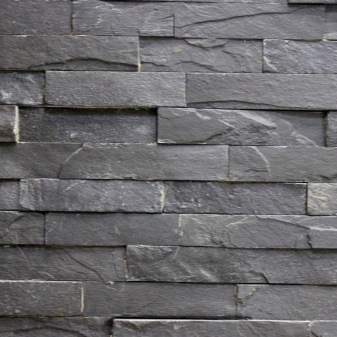
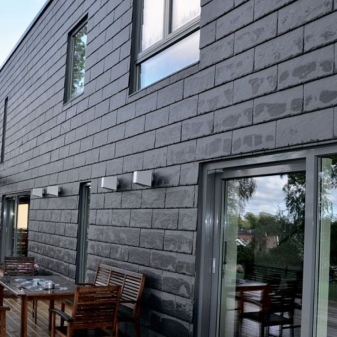
Modern manufacturers have brought facade cladding to a new level. Artificial stones may outwardly do not differ at all from natural materials and are not inferior to them in terms of durability and strength. And at the same time, they have a significantly lower weight, which makes it possible not to carry out additional work to strengthen the facade. And besides, working with cladding panels is much easier and faster.
Strong and reliable analogs have filled the entire construction market. And manufacturers do not give any doubts about the durability of artificial stones - some types of alternative materials are guaranteed for up to 100 years.
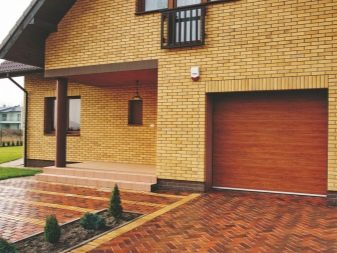

Clinker bricks or tiles can mimic both brick and chipped stone.
The basis of the material is clay. After the formation of the shape, the stone undergoes high-temperature treatment and is fired in a furnace at a temperature of 1200 ° C, which makes it possible to achieve high strength and reliability of the material. In addition, clinker tiles are highly frost-resistant, durable and UV-resistant.
In the production of stone from concrete, high-strength cement is poured into the mold and compacted on a vibrating table. Artificial concrete stone can be given any color, even at home. Experts also recommend covering the stone with a strengthening soil for three years. Thus, it will serve for about 30 years.
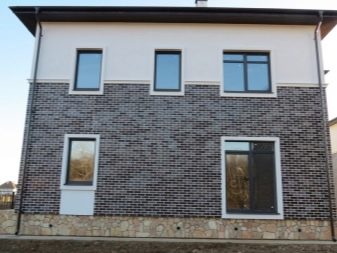
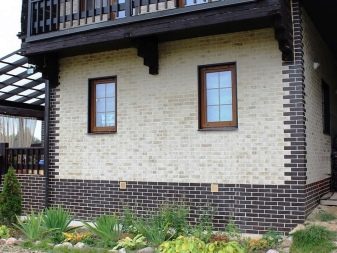
The process of producing architectural stone is no different from concrete. Only in this case, high-strength white cement is used. Architectural stone can be of any shape, repeating openwork details and curved lines.Most often, architectural stone is used to partially decorate the facade and is placed near doors, window openings, and also under the roof.
Polymer sand panels are based on polymers and sand.

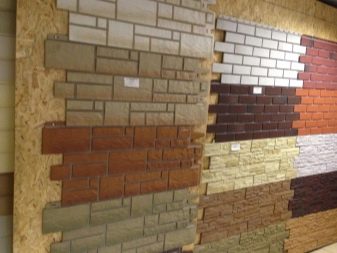
In this case, the sand is used more for shading and economy than for strength.
Synthetic resin panels perfectly imitate natural stone. Synthetic resins are used as a bonding material, and the basis of the panel is dust and natural stone chips, which allow creating an amazingly beautiful natural pattern.
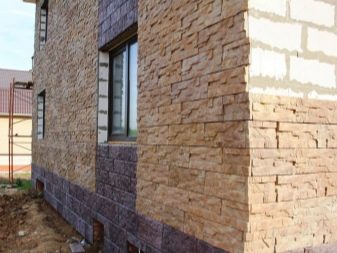
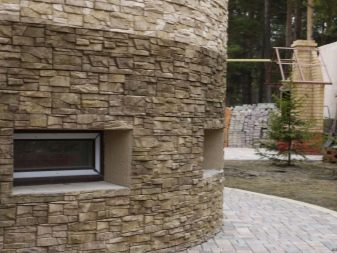
Flexible stone is a modern coating with excellent imitation of stone in color, pattern and texture. Flexible cladding is made by hand and is best suited for open pit sandstone. The flexible stone contains a natural stone cut, due to which, at first glance, the fixed coating does not differ from natural stone. A small layer of natural material no more than 3 mm thick is applied to the outside of the fabric surface. The finished coating combines the advantages of natural and decorative material. The unique structure of flexible stone is lightweight, has excellent moisture resistance and fire resistance.
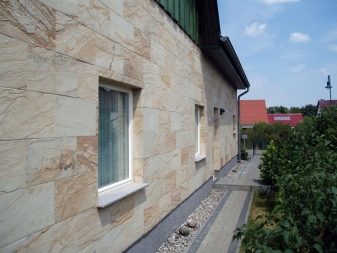
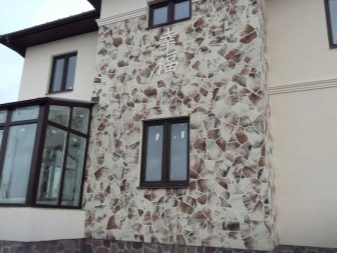
Colors and designs
Stone decor will perfectly complement many architectural styles and trends. "Wild" stone with a unique pattern allows you to create an excellent composition on the facade. This is possible due to the laborious work of extracting and preparing the material for cladding. To do this, large stone slabs are split into a large number of smaller pieces.
All natural factors influence the composition and structure of the stone: rain, snow, wind, sun.
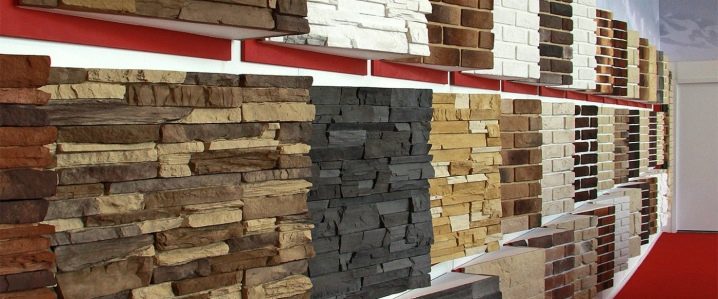
Depending on the specific climatic zone, organic and inorganic substances are formed. Therefore, all stones are unique in their own way - they have different sizes and shapes, torn edges and a rough surface. By harmoniously combining colors and textures, you can create the most unusual combinations and variations of cladding.

As you know, the color palette creates mood and influences perception. Natural stones have a beautiful pure color and many different shades. Natural and artificial lighting affects the perception of a stone in different ways.
Therefore, when choosing the color of the cladding, it is worth following a few rules:
- The architectural style of the house influences the color of the building. Assess the exterior of the building and try to find a suitable palette. So, for example, in a classic style, it is unacceptable to use bright and catchy colors that will perfectly complement the style of modern solutions. Complex architecture will look much more effective in a neutral and calm palette.
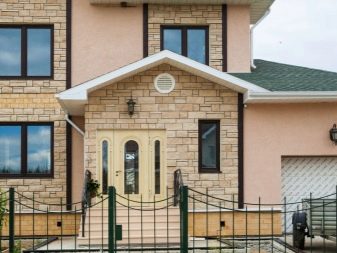
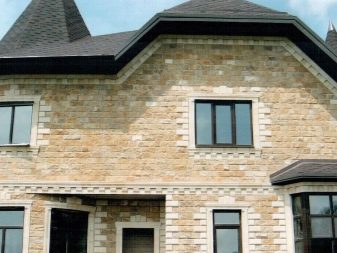
- In most cases, it is wiser to choose light shades: white, pale beige and other milky tones. They blend harmoniously with the natural landscape all year round.
- Yellow, green, blue and other colors related to nature look cozy and rosy on the facade.
- Gray belongs to the category of neutral tones and goes well with other colors. Gray is not always associated with melancholy and gloom, it is great for the facade of a house in the style of a medieval castle or fortress.
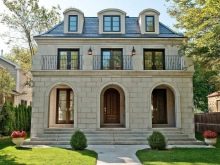
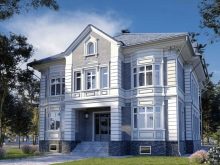
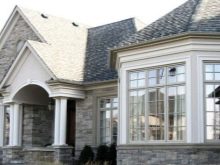
- But you should think carefully before using a dark palette. It is best suited for houses with simple shapes. The main feature of dark colors is that they attract the sun's rays, therefore, on a hot day, the cladding will quickly heat up, which will cause the artificial surface to fade and lose its rich color.
- And although bright and saturated colors will visually increase the area and make the house stand out against the background of other buildings, they will also quickly change color in direct sunlight.
- When decorating the facade, you can combine several shades. Shades of the same palette are well combined, for example, from dark brown to beige.

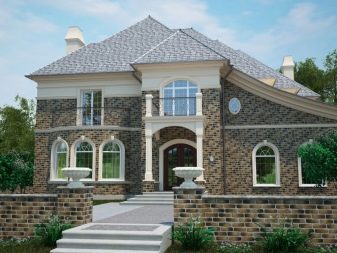
- Perhaps one of the most popular options is the combination of rich red and brown in suburban construction. Brick color goes well with white window frames and a dark roof. These colors are great for buildings with simple architecture.
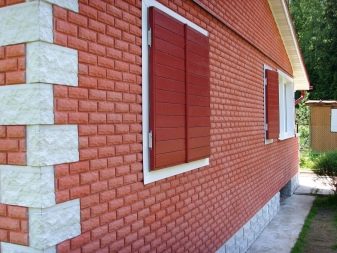

- And to give a finished look to the site, you can decorate the porch, stairs, paths and areas with stone. A stone veneer is perfect for this. It consists of sheets with a relief surface. The veneer has a wide range of colors and textures, therefore it can be suitable for combination with any veneer material.
- You can also use stone decor in the interior. For indoor use, "torn" stone is ideal, which undergoes additional processing in production. On the front side, the stone retains a relief surface and a natural pattern, and on the back side it has a smooth surface to facilitate installation work.
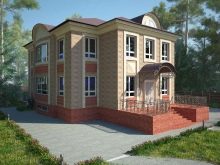
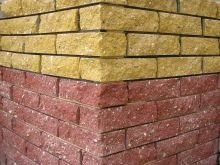
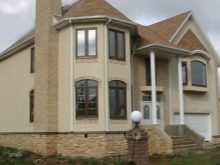
How to choose?
Facing stone allows you to embody any bold design solutions and ideas when decorating the facade. All facing materials differ in strength, external characteristics and resistance to various factors. And in this case, it is impossible to select the best stone.
Limestone, sandstone, slate and artificial stones are mainly used for cladding private houses.
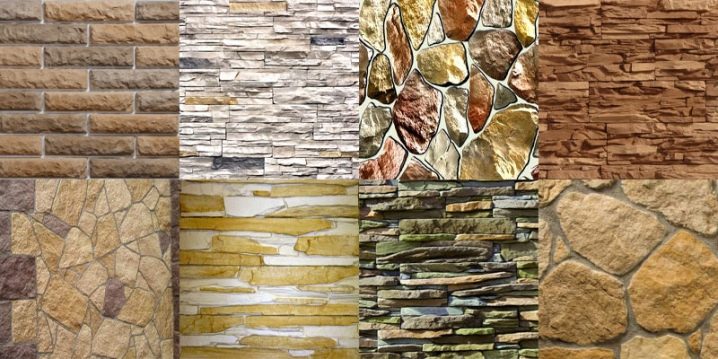
And for the decoration of the basement and first floors of administrative buildings, granite or marble is most often used. When choosing a facing material, you must first of all focus on your wishes and needs, which may be related to the appearance of the stone, its cost or other factors.
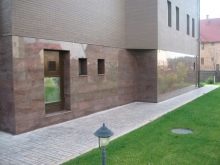
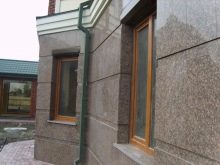
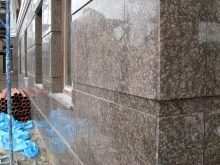
When decorating the facade with facing material, you should also pay attention to the other elements:
- base;
- window frames;
- doorways;
- garage doors;
- stairs.
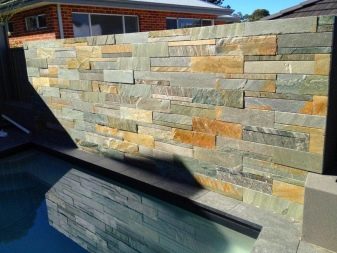
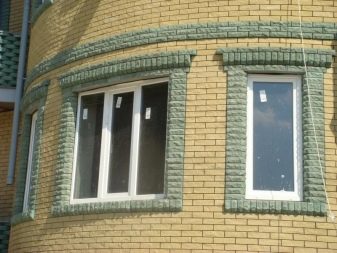
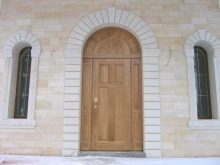
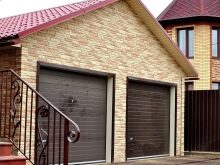
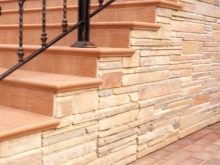
Also, facing stone can be used not only for exterior decoration, but also for interior decoration. But like any finishing material, the stone undergoes industrial processing, after which the material receives the necessary structure:
- "Rock" - preserves the natural texture as much as possible. Such a stone is harmoniously combined with metal forged elements.
- Bush-hammered - on the surface of the stone, traces of punctual strong impacts are formed.
- Sanded - as the name implies, the surface of the stone has an even and smooth texture.

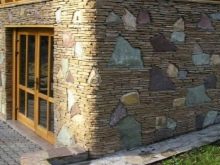
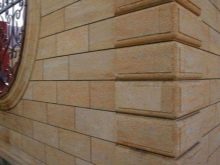
- Glossy - outwardly similar to sanded, but has a matte surface.
- Polished - has a shiny glossy, almost mirror-like surface.
- Sawn - has a rough surface. This decor is great for a log home.
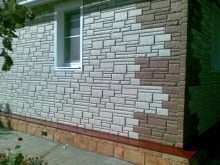
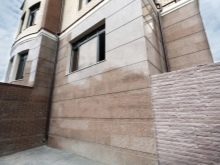

Of course, natural stone is not cheap, besides, half of the total cost of the material is processing and calibration. Of course, the money spent will pay off over time, since natural stone can last about 100 years. But you can also use artificial stone for cladding without embarrassment.
The price for decorative materials is much lower and it is easier to work with them than with natural ones. But if you nevertheless decide to choose natural stone for finishing the facade, then listen to the feedback, entrust the cladding work to experienced specialists.
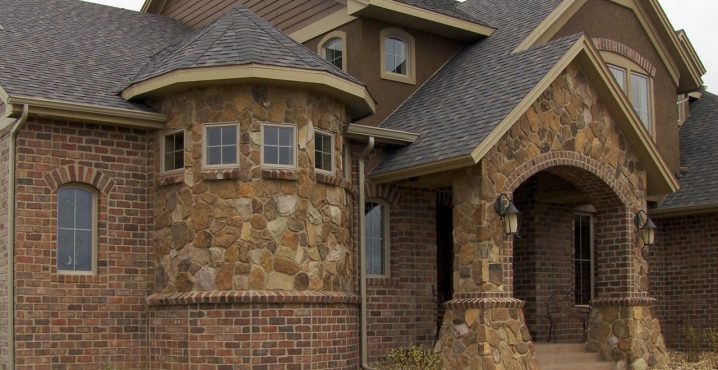
Types of masonry
It is necessary to choose the appropriate finishing option taking into account the style of the house and the site. The type of facade of the house depends on the selected type of masonry.
Facing with a die allows you to get a natural natural pattern and is considered the most affordable way of laying.
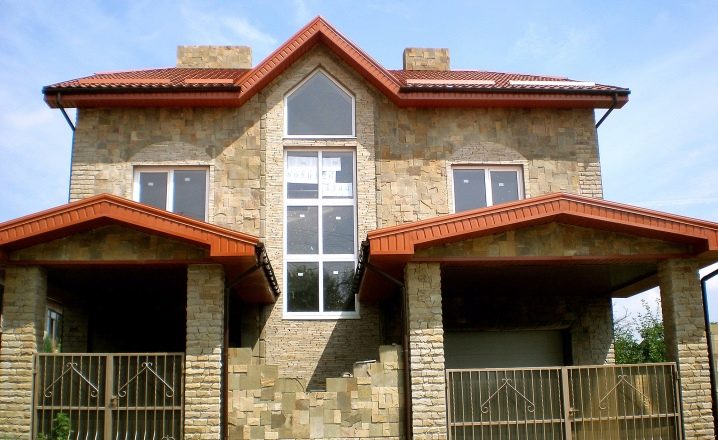
The most commonly used natural raw materials are sandstone, shale, limestone and some types of dolomite. The cost of such masonry is practically the same as for facing with artificial materials.
No additional processing of the material is required before laying, which allows you to create a picture more close to the natural style.
- Complexity of masonry dice is to select different materials in size so that gaps do not form between the elements.
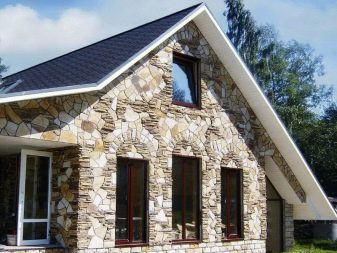
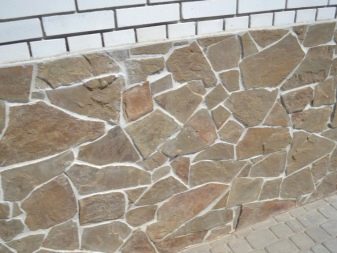
- Caste translated from English means "castle". With such laying, the cladding should be as close as possible to a medieval castle. Sandstone, slate, limestone, marble, granite are excellent for this type of masonry. And you can also use more affordable artificial materials. For such masonry, stones of a rectangular shape measuring 5x10 cm with uneven and chipped sides are best suited. The sizes of stones can be different, but a prerequisite is that the shape must be rectangular.
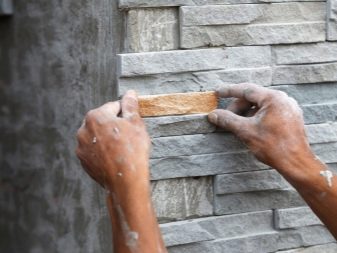
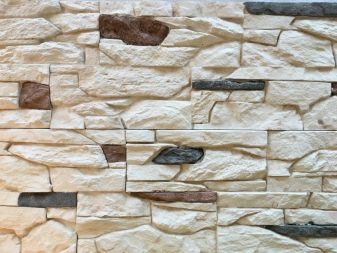
- Plateau - curly way of laying, which has nothing to do with natural natural pattern. The stone can have a rectangular or square shape, and for the convenience of masonry, its edges are processed. The side of the stone must be a multiple of 5. But the process of laying is complicated by the fact that it is necessary to adjust and distribute stones of different shapes so that the veneered facade looks complete and stylish. Often, the type of plateau masonry is used when decorating the basement, windows and corners of a building.
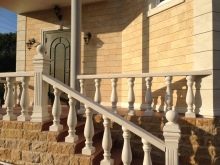
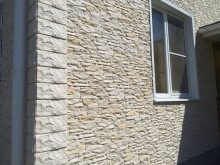
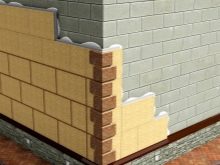
- When laying shahriar all elements are rectangular, which greatly facilitates the masonry process. The edges of each element have a border, which is a distinctive feature of this masonry. The surface of the stone can be chipped in relief, polished or smooth. But after polishing, the stone looks more like a brick, so stones with a natural rough surface are very popular. Even a beginner can cope with this method of laying, the whole difficulty lies only in laying the first layer evenly, after which the process of work will be greatly facilitated.

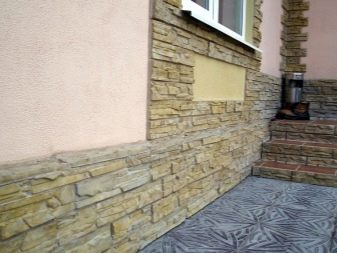
- Assol - thin elongated rectangular plates are used for such masonry. They can be made from both natural and artificial stone. Shale and sandstone are most commonly used as the base. Facing the wall with Assol masonry creates the illusion of a massive massive facade. But installation work takes a lot of time and effort, since each stone has its own thickness, it is not so easy to create a harmonious composition with an even number of rows.
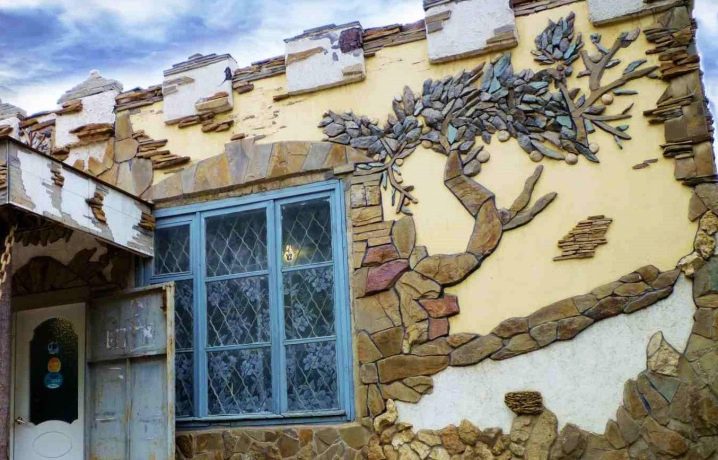
- Rondo - an unusual type of styling in a nautical style. For cladding, pebbles or other rounded river stones of different sizes are used. The material does not undergo additional processing and is used in its original form. Finishing the entire wall with rondo masonry is rare, most often cladding of small areas on the facade is used: doorways, windows, porch and basement. The rondo masonry process is much simpler than other options. First of all, large stones are attached to the facade, and then smaller elements are fixed in small openings and cracks.
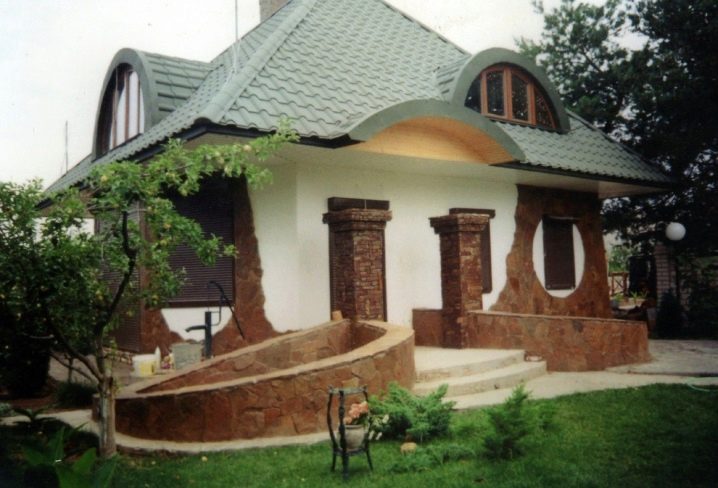
Quantity calculation
To make an estimate and calculate the approximate cost of the work, it is necessary to determine the surface area for the cladding. To do this, the height of the wall is multiplied by the width. But at the same time, you do not need to take into account the area of windows, doors and other areas that cannot be finished. Then the total area of the facade of the entire building is calculated. The resulting figure is divided by the area of one stone. This method of counting is suitable if all finishing units are of the same size.
Some manufacturers offer additional corner stones to facilitate the work.

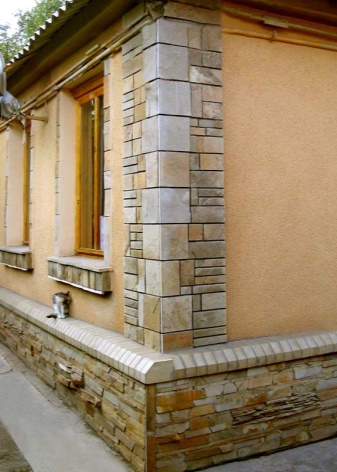
To calculate their volume, it is necessary to add the length of all the corners of the building and divide by the height of one stone.
It is necessary to buy material with a margin for unforeseen expenses and force majeure. Therefore, 10% must be added to the total. This amount is enough both for adjusting the material and for cutting when the stone is deformed.
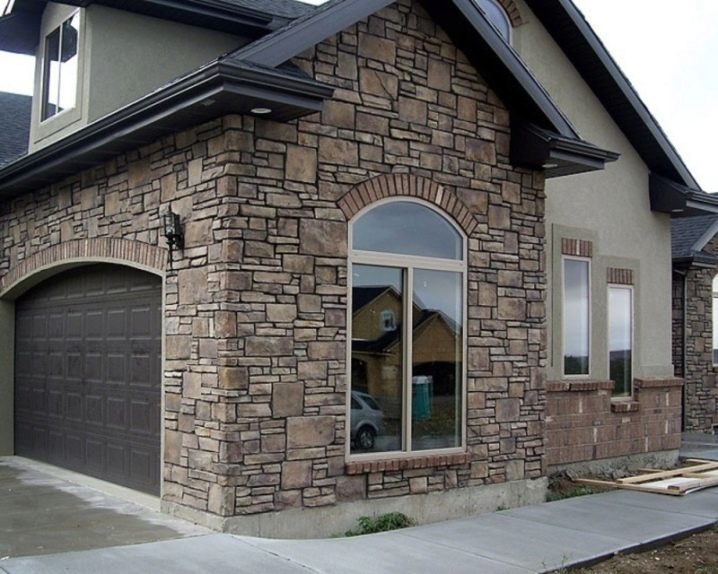
Mounting
Natural and artificial stones are assembled according to the same principle. At the same time, it is important to follow all strict rules and recommendations.Any installation work with a stone must be carried out at a temperature of + 6 ° C to + 25 ° C. When decorating the facade, it is not necessary to cover all the walls with stone. In some cases, a partial building cladding is considered a more advantageous option. Even a beginner can do such a task with his own hands.
Before starting work, we advise you to draw the future facade of the house in order to clearly understand in what sequence to use various materials.
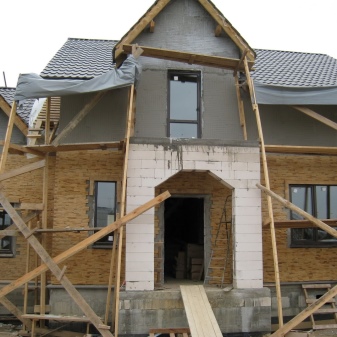
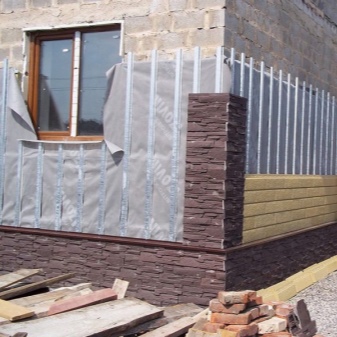
The general picture of the stone must be selected in advance in small areas on a horizontal surface not far from the wall. This will make it easier to transfer the drawing to the facade.
It is also necessary to prepare the surface of the walls for subsequent work.
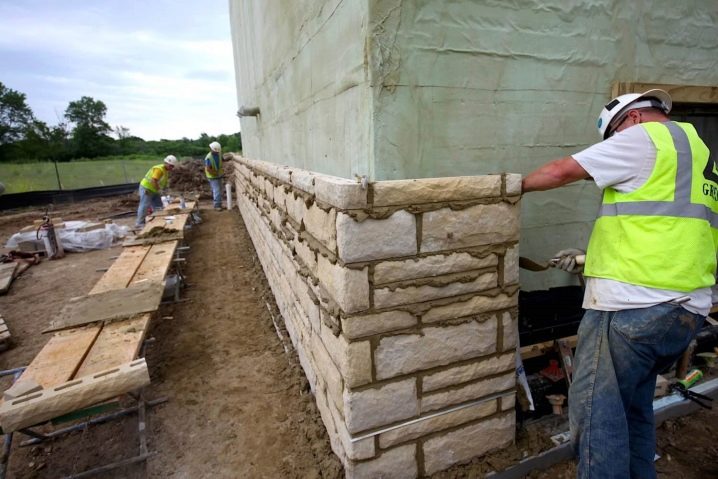
The key point in this case is the moisture content of the facade. For cement walls, 4.5% is optimal, and for wood or drywall - no more than 0.5%.
Old paint, cladding and insulation are removed from the facade. This is necessary in order to reduce the stress on the walls. The surface should also be perfectly smooth and even without any dramatic changes. For this, all irregularities are eliminated, cleaned and primed. The surface is cleaned of dust and debris. The facade of the building must be covered with deep penetration soil to strengthen the structure.
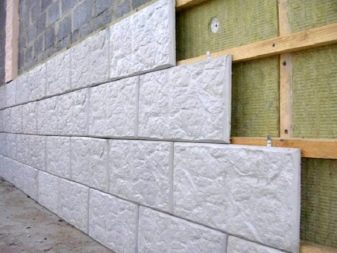
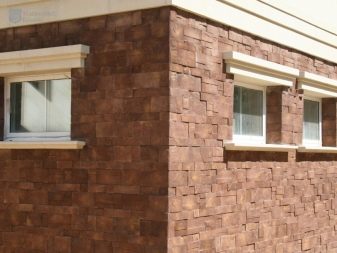
The facing stone can be attached to the facade using self-tapping screws or glue. In this case, we will consider the option of attaching it to a special construction adhesive. Therefore, the next step will be to fix the metal mesh to the wall for future plastering.
At the level of the lower layer of laying the stone, a metal corner or a wooden block is installed.

It is necessary in order to ensure an even laying. After that, it is necessary to dilute the trowel building glue and apply the composition with a thickness of about 2 cm to the reinforced wall. Also, glue must be applied to the stones from the seamy side. All elements are pressed against the wall with force. You can tap the surface lightly with a rubber mallet. The solution protruding from all sides of the stone is carefully removed with a spatula.
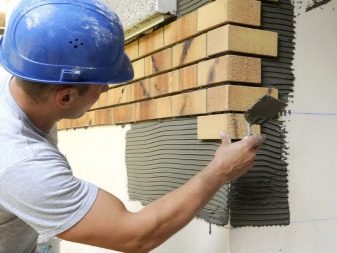

After the completion of the installation work and the partial drying of the wall, it is necessary to seal the joints between the stones. The simplest analogue of a building device is a plastic bag. To do this, it is filled with jointing material and a small corner of the polyethylene is cut off. Thus, a kind of "pastry bag" is obtained, with the help of which you can gradually fill all the seams with a solution.
The finishing touch is the treatment of the new facade with a water-repellent protective agent, which will additionally protect the facade of the house from natural phenomena.
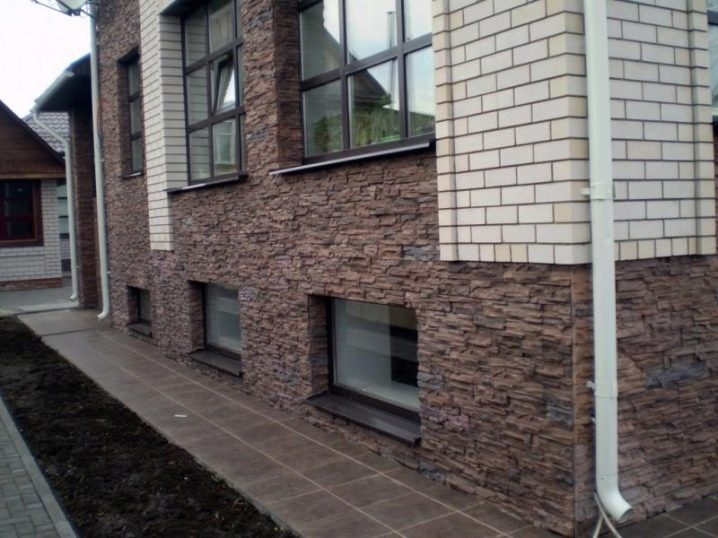
Finishing examples
- With the help of a facing stone, you can focus on the house and make it unique, as well as emphasize the advantages and hide surface imperfections.
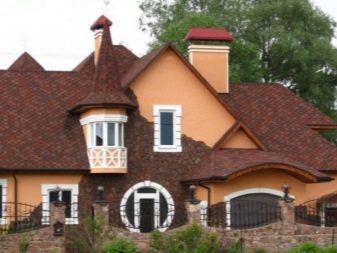
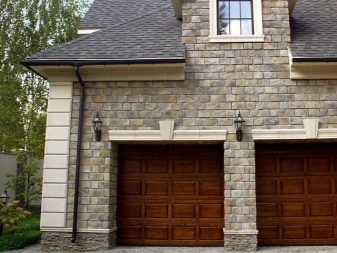
- An original way of finishing the facade is the stone cladding of the vertical and horizontal zones of the house. The remaining areas can be covered with light-colored plaster. This combination will create a beautiful contrast of neutral tones with the cool color of the stone.

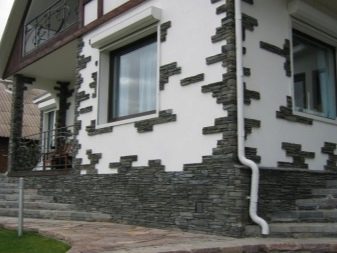
- The stone décor on the outside gives the house a presentability and history.
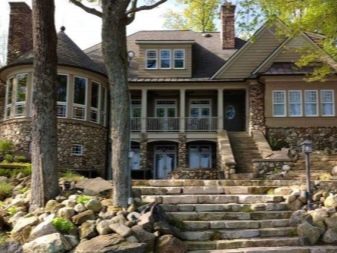
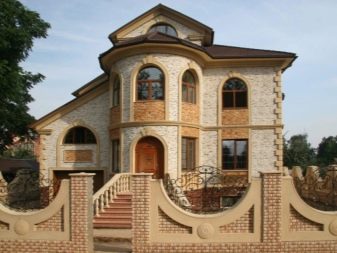
- Architectural artificial stone can decorate the entrance group or window openings.
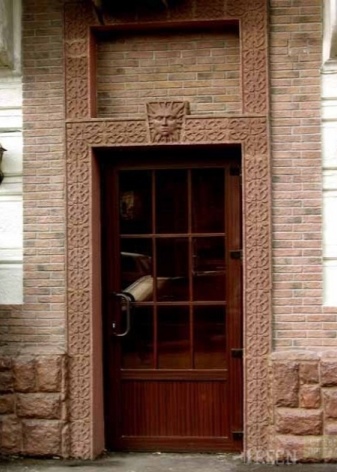
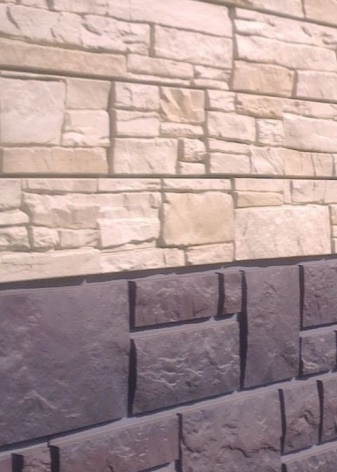
- Other buildings trimmed with stone, a gazebo, a fence and paths on the site will give the site a finished look.
- And also from some types of stones, you can create railings, arches and even columns. But such structures will have an impressive weight, therefore, in some cases, it is easier to revet the finished forms with natural or artificial stone.
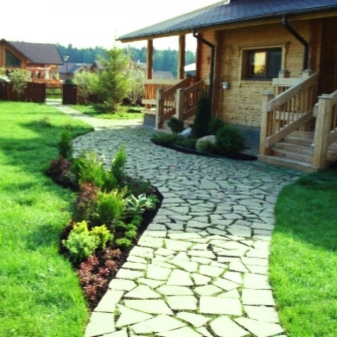
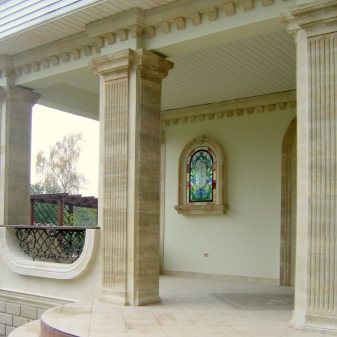
See below for details.













The comment was sent successfully.